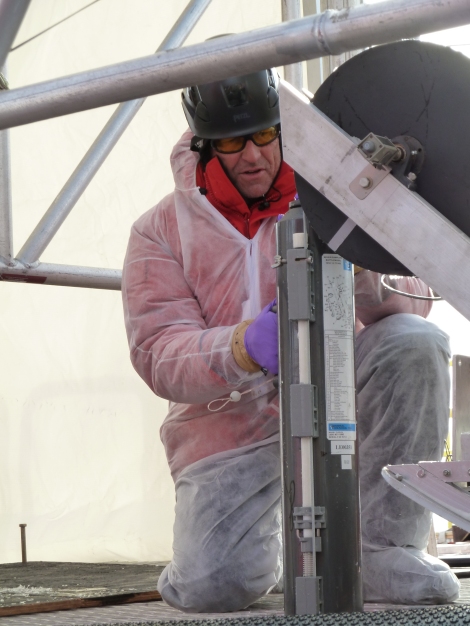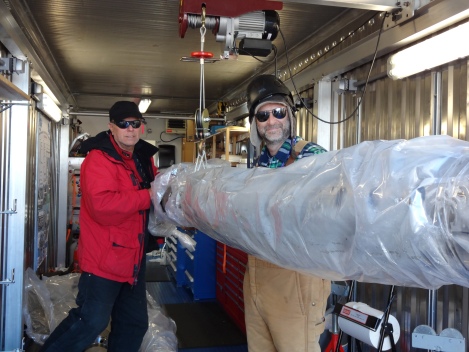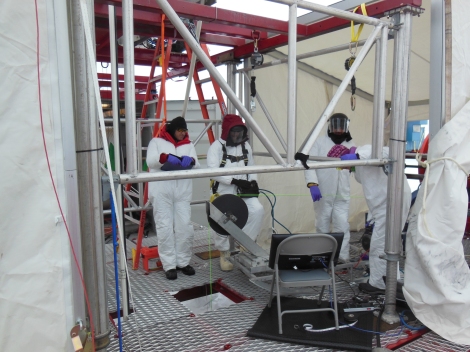WISSARD’s Groundbreaking Exploration of Antarctica’s Subglacial Environment
BIG SCIENCE NEWS!!! Here’s the latest information (from our press release, in italics), with photos from various team members, including myself. I’ll also be posting a second blog today…with another great story about our flight to the Subglacial Lake Whillans field camp yesterday!
US Science Team Reaches Subglacial Lake Whillans — A Drilling and Scientific Achievement!
Years of planning and preparation among national and international scientists, engineers, and technological design teams arrived at an exciting benchmark achievement. The WISSARD field team successfully drilled through the overlying ice sheet to access subglacial Lake Whillans.
Congratulations to the WISSARD drilling team (from left to right): Jeff, Daren, Dar, Dennis, Chad, Graham, and Justin. (Photo: JT Thomas)
The drillers are watching the live video sent by the mothership (via computer monitor) as it visually inspects the borehole. (Photo: Chad Carpenter)
This effort marks the first successful clean drilling/access to an Antarctic subglacial lake. Scientists are taking samples of water and sediments that will be immediately processed to answer questions related to our science objectives outlined in my earlier blogs. (see January 9, 16, 19) This includes gaining new insights into subglacial microbial life, climate history, and present day ice sheet dynamics.
Chief Scientist, John Priscu, preparing to deploy a Niskin bottle to collect a water sample. (Phot0: Reed Scherer)
The interdisciplinary team of WISSARD scientists represents a combination of U.S. universities and two collaborating international institutions. This team includes experts on life in icy environments (led by Prof. John Priscu, Montana State University), glacial geology (led by Prof. Ross Powell, Northern Illinois University) and glacial hydrology (led by Prof. Slawek Tulaczyk, University of California, Santa Cruz).
Lead Scientist, Ross Powell (left) and scientist Reed Scherer are preparing to deploy the POP (physical oceanographic package) instrumentation. It has been cleaned and packaged prior to deployment to ensure clean access sampling. (Photo: Betty Trummel)
Lead Scientist, Slawek Tulaczyk (far left) works with scientists on the drilling deck to monitor the mothership as it is sent down the borehole. The camera on the mothership gives scientists a chance to see the hole; notice they have a computer monitor there to follow the camera in real time. (Photo: Reed Scherer)
To enable clean access into subglacial Lake Whillans a team of engineers and technicians, directed by Dr. Frank Rack (University of Nebraska – Lincoln) spent nearly two years building a new hot-water drill capable of melting through 2,500 feet of ice in just a few days. It can blast a pressurized hot water jet at up to fifty gallons a minute, a rate equivalent to eight hundred 8 ounce glasses per minute. The drill is connected to a truck-size water filter that will remove cells and particles larger than eight one millionths of an inch, and kill any remaining cells with a powerful dose of UV radiation. All drill parts and scientific tools entering the borehole will have been pre-cleaned with hydrogen peroxide and go through a microbe-killing UV chamber. Such cleaning will ensure that we remain stewards of this remote environment while at the same time protecting the integrity of the precious samples that we hope to obtain from the subglacial environment.
As you know the WISSARD drill, along with fuel, field laboratories, workshops, computerized control centers, and scientific instrumentation as well as a deck and crane to support field operations, arrived at the Lake on January 12, 2013 after an arduous (very hard) journey from the U.S. McMurdo Station. In a feat of ultimate ‘ice road trucking’, these hundreds of thousands of pounds of cargo were brought to the site on giant sleds dragged for two weeks behind powerful tractors. The traverse route paralleled the first half of the famous trek that Scott’s expedition took to the South Pole in 1911. Members of his team would have been awed by the fact that barely over one century after their hard journey, transportation of hundreds of tons of equipment has become almost a routine, though still not trivial, task.
WISSARD’s groundbreaking exploration of Antarctica’s subglacial environment marks the beginning of a new era in polar science, opening the window for future interdisciplinary scientific investigations of one of Earth’s last unexplored frontiers. Thanks in large part to the education and outreach components of WISSARD, the project has been followed closely by people across the globe and we hope that our efforts will inspire the next generation of polar scientists.
We’ve had extraordinary support from the 139th Expeditionary Airlift Squadron of the NY Air National Guard, Kenn Borek Air, and by many dedicated individuals working as part of the Antarctic Support Contractor, managed by Lockheed-Martin. Core funding for the WISSARD project came from the National Science Foundation – Office of Polar Programs (NSF-OPP; http://www.nsf.gov/dir/index.jsp?org=OPP), with additional funds for instrument development provided by the National Aeronautics and Space Administration – Cryospheric Sciences Program (NASA-CSP; http://ice.nasa.gov/), National Oceanic and Atmospheric Administration (NOAA; http://www.noaa.gov/), and the Gordon and Betty Moore Foundation (http://www.moore.org/).
Driller Dar Gibson, shovels more snow into the melter. (Photo: Chad Carpenter)
Graduate student Alex Michaud and scientist Andy Mitchell are using the light winch to help lower the mothership. (Photo: Reed Scherer)
An overall view of the drilling deck, with Jack in the background, holding the drill nozzle. (Photo: Reed Scherer)
A close-up of the nozzle. (Photo: Chad Carpenter)
Several great news articles have been released in the U.S. today. I even made the local paper! Check out:
US scientists reach new frontier at Antarctica’s Lake Whillans
“This is a first go,” said Ross Powell of the University of Northern Illinois, one of WISSARD’s 13 principal investigators. “Next year we hope to return to drill more holes.”
http://www.msnbc.msn.com/id/50610244/ns/technology_and_science-science/#.UQaVo2f_2dc
Pay Dirt! Antarctic drilling reaches surface of lake buried beneath ice
In a Scientific and Engineering Breakthrough, NSF-funded Team Samples Antarctic Lake Beneath the Ice Sheet
http://www.nsf.gov/news/news_summ.jsp?org=NSF&cntn_id=126697&preview=false
And here are a few more!
http://www.nwherald.com/2013/01/25/on-the-record-with-betty-trummel/aqqg6zy/?page=1
http://news.discovery.com/earth/antarctic-drilling-reaches-lake-whillans-130128.htm
http://www.bbc.co.uk/news/science-environment-21231380
Stay tuned for another blog later today…more about the SLW field camp and our flight out yesterday!










That is so awesome. What a success!
Go WISSARD! 🙂
How cool to be a part of this. Keep up the great posts so we can live vicariously! Joy
Hi Joy….I will keep up the posts! I’ll be back in CL soon! 🙂
Keep up the good work
Thanks Lizbeth! I’ll be back to Husmann soon! 🙂
Wow that’s so cool I can’t wait to see you when will you be back? I live your blogs they are so awesome we miss you
Your cool
I did not write that
Sorry It’s Leah I accidentally used Sarah’s name what I wanted to say was that I did not write that someone else did and used my name 😦
Hi Leah,
I miss you too and all of my Husmann friends! Glad you like the blogs! Keep reading and learning! 🙂
I love u mrs tumle
Who is me?
Your blogs are so cool. I can’t wait to read the next one! There always so exciting! I thought school would be boring but your blog is the highlight of my day!
Keep up your great work and awesome blogs!
P.S how long does I take you to write a blog?
And when do you write them?
Its supposed to say P.S how long does it take you to write a blog no I
That’s GREAT news, Rebekah! I’m so happy you are excited about the blogs. It takes me 5-6 hours a day to write each blog. I have photos to download and then put into the blog, I have a first draft I work on, then I revise/edit that many times before I’m ready to post it. It’s heaps of work, but I enjoy the writing. I write them all day and night….I work from early morning to VERY late at night. And, remember, I have to interview people and gather my ideas first….I just don’t start writing. It’s really great to have a record of what I learned down here and to share it with all of you. 🙂 See you back at Husmann very soon! 🙂
❤
It’s supposed to be a heart
Hi Mrs.Trummel! It’s Leah I love your blogs! Do u really post 1 every day!? I know u do but in my world it just seems impossible! Your so busy I just don’t know how u do it!
Stay warm,
From Leah!
🙂
Hello again Leah….I don’t know how I do it either…..it takes a LONG time each day…but I enjoy teaching everyone while being here in Antarctica. I don’t sleep enough! I am a busy person…but I enjoy staying busy and LEARNING every single day! 🙂
Betty,
When people drill for oil and ‘strike it’ the oil forces itself to the surface.
Why doesn’t the water from Subglacial Lake Whillans force its way up the bore hole?
incredible find by the WISSARD scientists.
prof prem raj pushpakaran
http://www.incredb.org/investigator.php?incredb_id=373